Operations Management > QUESTIONS & ANSWERS > WGU C215 Operations Management - Objective Assessment Prep Guide & Terminologies Combo Study Guide (All)
WGU C215 Operations Management - Objective Assessment Prep Guide & Terminologies Combo Study Guide
Document Content and Description Below
WGU C215 Operations Management - Objective Assessment Prep Guide & Terminologies Combo Study Guide 1. customer focus 2. continuous improvement 3. employee empowerment 4. use of quality tools 5.... product design 6. process management 7. managing supplier quality ✔✔Total Quality Management (TQM) Philosophy Basic function of Six Sigma. Measures the process potential and performance of processes. The higher the range of Cpk, the improved is the ability of the process to complete its necessities. Uses both the process variability and the process specifications to determine whether the process is "capable." ✔✔Process Capability Index (Cpk) A disciplined, data-driven approach and methodology for eliminating defects (driving toward six standard deviations between the mean and the nearest specification limit) in any process - from manufacturing to transactional and from product to service. ✔✔Six Sigma The theoretical maximum output of a system in a given period under ideal conditions. ✔✔Design Capacity The capacity a firm expects to achieve given its current operating constraints. ✔✔Effective Capacity proximity to customers, transportation, source of labor, community attitude, proximity to suppliers, and many other factors. ✔✔Location AnalysisA type of process used to produce a large volume of a standardized product. ✔✔Line Processes A type of process used to produce a small quantity of products in groups or batches based on customer orders or specifications. ✔✔Batch Processes A type of process used to make a one-at-a-time product exactly to customer specifications. ✔✔Project Processes A type of process that operates continually to produce a high volume of a fully standardized product. ✔✔Continuous Processes Longest task in the process. ✔✔Bottleneck A type of automated system that combines the flexibility of intermittent operations with the efficiency of continuous operations. ✔✔Flexible Manufacturing System (FMS) A technique for monitoring the flow of jobs between work centers. ✔✔Output/Input Control The net increase created during the transformation of inputs into final outputs. ✔✔Value-Added Layouts that combine characteristics of process and product layouts. ✔✔Hybrid Layouts Table that reflects opinions of managers with regard to the importance of having any two departments close together. ✔✔Relationship Chart (REL) The shortest distance between two locations using north-south and east-west movements. ✔✔Rectilinear DistanceTable that gives the number of trips or units of product moved between any pair of departments. ✔✔From-To Matrix Schematic showing the placement of resources in a facility. ✔✔Block Plan The average of the observation times for each of the work elements. ✔✔Mean Observed Times The mean observed time multiplied by the performance rating factor by the frequency of occurrence. ✔✔Normal Time The length of time it should take a qualified worker using appropriate process and tools to complete a specific job, allowing time for personal fatigue and unavoidable delays. ✔✔Standard Time A philosophy designed to achieve high-volume production through elimination of waste and continuous improvement. Based on a "pull" system rather than a "push" system. The three elements are just-in-time manufacturing, total quality management, and respect for people. ✔✔Just-in-Time (JIT) A card that specifies the exact quantity of product that needs to be produced. ✔✔Kanban card A philosophy of neverending improvement. ✔✔Continuous Improvement Supplies materials or services directly to the processing facility. ✔✔Tier One Suppliers Directly supplies materials or services to a tier one supplier in the supply chain. ✔✔Tier Two Suppliers Directly supplies materials or services to a tier two supplier in the supply chain. ✔✔Tier Three SuppliersManagement of the flow of materials from suppliers to customers in order to reduce overall cost and increase responsiveness to customers. ✔✔Supply Chain Management (SCM) Determines the labor and machine resources needed to fill the open and planned orders generated by the MRP. ✔✔Capacity Requirements Planning (CRP) A system that uses the MRP, inventory record data, and BOM to calculate material requirements. ✔✔Material Requirements Planning (MRP) Large software programs used for planning and coordinating all resources throughout the entire enterprise. ✔✔Enterprise Resource Planning (ERP) Includes the budgeted levels of finished products, inventory, backlogs, workforce size, and aggregate production rate needed to support the marketing plan. ✔✔Aggregate Plans Businesses to outsource elements of the company's distribution and fulfillment services. specialize in integrated operation, warehousing and transportation services customized to customers' needs based on the demands and delivery service requirements for their products and material ✔✔ThirdParty Logistics (3PL) the world's leading supply chain framework, linking business processes, performance metrics, practices and people skills into a unified structure. The goals are to increase the speed of system implementations, support organizational learning goals, and improve inventory turns. ✔✔Supply Chain Operations Reference model (SCOR) Initiation, Planning, Execution and Closure. ✔✔Project Life Cycle Phases A plan for produced in each time period such as production, staffing, inventory, etc.linked to manufacturing where the plan indicates when and how much of each product will be demanded. It gives production, planning, purchasing, and top management the information needed to plan and control the manufacturing operation. ✔✔Master Production Schedule (MPS) The meaning of quality as defined by the customer. ✔✔Total Quality Management (TQM) network diagramming notation that places activities in the nodes and arrows to signify precedence relationships ✔✔activity-on-node provides users with information on services and products and provides an opportunity for suppliers to advertise ✔✔advertising revenue model companies receive a referral fee for directing business to an affiliate ✔✔affiliate revenue model includes the budgeted levels of finished products, inventory, backlogs, workforce size, and aggregate production rate needed to support the marketing plan ✔✔aggregate plan computer software packages for designing process layouts ✔✔ALDEP and CRAFT the amount of time the analyst allows for personal time, fatigue, and unavoidable delays ✔✔allowance factor brings work to the worker rather than the worker to the workplace ✔✔alternative workplace inventory built in anticipation of future demand ✔✔anticipation inventory sets up and runs ERP systems ✔✔application service provider (ASP)costs incurred in the process of uncovering defects ✔✔appraisal costs produces standard components that can be combined to customer specifications ✔✔assemble-toorder strategy causes that can be identified and eliminated ✔✔assignable causes of variation a method using telephone models to send digital orders to suppliers ✔✔automated order entry system unfilled customer orders ✔✔back orders starts with the due date for an order and works backward to determine the start date for each activity ✔✔backward scheduling scheduling method that determines when the job must be started to be done on the due date ✔✔backward scheduling a type of process used to produce a small quantity of products in groups or batches based on customer orders or specifications ✔✔batch process degree to which the job is intrinsically satisfying to the employee ✔✔behavioral feasibility studying the business practices of other companies for purposes of comparison ✔✔benchmarking the volume of output that results in the lowest average unit cost ✔✔best operating level typically represents project activities ✔✔beta probability distributionlists all the subassemblies, component parts, and raw materials that go into an end item and shows the usage quantity of each required ✔✔bill of material (BOM) schematic showing the placement of resources in a facility ✔✔block plan longest task in the process ✔✔bottleneck technique used to compute the amount of goods that must be sold just to cover costs ✔✔breakeven analysis a philosophy that encompasses the entire organization ✔✔broad view of JIT tasks and procedures are important only if they meet the company's overall goals ✔✔broad view of the organization inaccurate or distorted demand information created in the supply chain ✔✔bullwhip effect a long-range plan for a business ✔✔business strategy electronic commerce between businesses ✔✔business-to-business (B2B) businesses selling to and buying from other businesses ✔✔business-to-business e-commerce on-line businesses sell to individual consumers ✔✔business-to-consumer e-commerce (B2C) electronic commerce between businesses and their customers ✔✔business-to-customers (B2C) the maximum output rate that can be achieved by a facility ✔✔capacityadditional capacity added to regular capacity requirements to provide greater flexibility ✔✔capacity cushion the process of establishing the output rate that can be achieved by a facility ✔✔capacity planning a rough-cut capacity planning technique. MPS items are multiplied by historically determined planning factors for key resources ✔✔capacity planning using overall planning factors (CPOPF) determines the labor and machine resources needed to fill the open and planned orders generated by the MRP ✔✔capacity requirements planning (CRP) percentage measure of how well available capacity is being used ✔✔capacity utilization a group of options that allow the firm to change its current operating capacity ✔✔capacity-based options a chart that identifies potential causes of particular quality problems ✔✔cause-and-effect diagram placement of dissimilar machines and equipment together to produce a family of products with similar processing requirements ✔✔cell manufacturing a planning approach that varies production to meet demand each period ✔✔chase aggregate plan a list of common defects and the number of observed occurrences of these defects ✔✔checklist random causes that cannot be identified ✔✔common causes of variation capabilities that the operations function can develop in order to give a company a competitive advantage in its market ✔✔competitive prioritiesparts or subassemblies used in the final product ✔✔components how well a product or service meets the targets and tolerances determined by its designers ✔✔conformance to specifications a mathematical model in which one is trying to maximize or minimize some quantity, while satisfying a set of constraints ✔✔constrained optimization problem limitations or requirements that must be satisfied ✔✔constraints a philosophy of never-ending improvement ✔✔continuous improvement a philosophy of never-ending improvement ✔✔continuous improvement (kaizen) a type of process that operates continually to produce a high volume of a fully standardized product ✔✔continuous process charts used to evaluate whether a process is operating within set expectations ✔✔control charts the unique strengths of a business ✔✔core competencies a competitive priority focusing on low cost ✔✔cost the longest sequential path through the network diagram ✔✔critical path network planning technique, with deterministic times, used to determine a project's planned completion date and identify the project's critical path ✔✔critical path method (CPM)the coordinated interaction and decision making that occur among the different functions of the organization ✔✔cross-functional decision making software solutions that enable the firm to collect customer-specific data ✔✔customer relationship management (CRM) the ability to satisfy customer requirements ✔✔customer service the meaning of quality as defined by the customer ✔✔customer-defined quality electronic commerce between customers ✔✔customer-to-customer (C2C) prespecified items are counted daily ✔✔cycle counting modeling tool used to evaluate independent decisions that must be made in sequence ✔✔decision tree quantities under the control of the decision maker ✔✔decision variables broad view of operations, simplicity, continuous improvement, visibility, and flexibility ✔✔defining beliefs of JIT a group of options that respond to demand fluctuations through the use of inventory or back orders, or by shifting the demand pattern ✔✔demand-based options a Japanese award given to companies to recognize efforts in quality improvement ✔✔Deming Prize proven capacity calculated from actual performance data ✔✔demonstrated capacitydemand for component parts is based on the number of end items being produced ✔✔dependent demand the maximum output rate that can be achieved by a facility under ideal conditions ✔✔design capacity assumption that the activity duration is known with certainty ✔✔deterministic time estimate a condition in which the cost of each additional unit made increases ✔✔diseconomies of scale finished goods in the distribution system ✔✔distribution inventory responsible for movement of material from the manufacturer to the customer ✔✔distribution management time when the job is supposed to be finished ✔✔due date the expected length of time the different capacity level is needed ✔✔duration of the change using the Internet and Web to transact business ✔✔e-commerce the cost of the job should be less than the value it adds ✔✔economic feasibility a condition in which the average cost of a unit produced is reduced as the amount of output is increased ✔✔economies of scale the maximum output rate that can be sustained under normal conditions ✔✔effective capacityperforming activities at the lowest possible cost ✔✔efficiency ratio of actual output to standard output ✔✔efficiency a form of computer-to-computer communications that enables sharing business documents ✔✔electronic data interchange (EDI) an electronic request for a quote on goods and services ✔✔electronic request for quote (eRFQs) on-line catalogs of products made available to the general public by a single supplier ✔✔electronic storefronts establish standards based on previously completed time studies, stored in an organization's database ✔✔elemental time data identifies new products or modifications to existing products that are needed to support the marketing plan ✔✔engineering plan large, sophisticated software systems used for identifying and planning the enterprise-wide resources needed to coordinate all activities involved in producing and delivering products ✔✔enterprise resource planning (ERP) monitoring the external environment for changes and trends to determine business opportunities and threats ✔✔environmental scanning a constraint such as 6x ₁ + 3x ₂ = 30, used to specify that a requirement must be met exactly ✔✔equality constrainta weighted average of chance events, where each chance event is given a probability of occurrence ✔✔expected value (EV) costs associated with quality problems that occur at the customer site ✔✔external failure costs can be performed while the machine is still running ✔✔external setup intranets that are linked to the Internet so that suppliers and customers can be included in the system ✔✔extranets a procedure that can be used to evaluate multiple alternative locations based on a number of selected factors ✔✔factor rating a specific combination of values of the decision variables such that all of the constraints are satisfied ✔✔feasible solution identifies the sources and uses of funds; projects cash flows, profits, return on investment; and provides budgets in support of the strategic business plan ✔✔financial plan products sold to customers ✔✔finished goods products available for shipment to the customer ✔✔finished goods inventory scheduling that loads work centers up to a predetermined amount of capacity ✔✔finite loading a definition of quality that evaluates how well the product performs for its intended use ✔✔fitness for usea layout in which the product cannot be moved due to its size and all the resources have to come to the production site ✔✔fixed-position layout an organizational strategy in which the company attempts to offer a greater variety of product choices to its customers ✔✔flexibility a competitive priority focusing on offering a wide variety of goods or services ✔✔flexibility a company can quickly adapt to the changing needs of its customers ✔✔flexibility a schematic of the sequence of steps involved in an operation or process ✔✔flowchart provides a cushion against unexpected demand ✔✔fluctuation inventory facilities that are small, specialized, and focused on a narrow set of objectives ✔✔focused factories a formal, algebraic statement of a constrained optimization problem ✔✔formulation schedule that determines the earliest possible completion date for a job ✔✔forward scheduling how often the work element must be done each cycle ✔✔frequency of occurrence table that gives the number of trips or units of product moved between any pair of departments ✔✔from-to matrix a trend in business focusing on customers, suppliers, and competitors from a global perspective ✔✔global marketplace the process of locating facilities around the world ✔✔globalizationa constraint such as 4x ₁ + 7x ₂ ≥ 50, often used to model a requirement that must be satisfied ✔✔greater-than-or-equal-to constraint focuses on the role of the supply chain with regard to its impact on the environment ✔✔green supply chain management the total-period demand for an item ✔✔gross requirements hybrid layouts that create groups of products based on similar processing requirements ✔✔group technology (GT) or cell layouts the studies responsible for creating the human relations movement, which focused on giving more consideration to workers' needs ✔✔Hawthorne studies long-term option for increasing or decreasing capacity ✔✔hiring and firing a chart that shows the frequency distribution of observed values of a variable ✔✔histogram a philosophy based on the recognition that factors other than money can contribute to worker productivity ✔✔human relations movement a planning approach that uses a combination of level and chase approaches while developing the aggregate plan ✔✔hybrid aggregate plan layouts that combine characteristics of process and product layouts ✔✔hybrid layouts the demand for an item is unrelated to the demand for other items ✔✔independent demandan industry movement that changed production by substituting machine power for labor power ✔✔Industrial Revolution a specific combination of values of the decision variables such that at least one of the constraints is violated ✔✔infeasible solution scheduling that calculates the capacity needed at work centers in the time period needed without regard to the capacity available to do the work ✔✔infinite loading operations decisions related to the planning and control systems of the operation, such as organization of operations, skills and pay of workers, and quality measures ✔✔infrastructure a technique for monitoring the flow of jobs between work centers ✔✔input/output control processes used to produce a variety of products with different processing requirements in lower volumes ✔✔intermittent operations costs associated with discovering poor product quality before the product reaches the customer ✔✔internal failure costs a regular bottleneck ✔✔internal resource constraint requires the machine to be stopped in order to be performed ✔✔internal setup networks that are internal to an organization ✔✔intranets a measure of inventory policy effectiveness ✔✔inventory turnovera set of international standards and a certification focusing on a company's environmental responsibility ✔✔ISO 14000 a set of international quality standards and a certification demonstrating that companies have met all the standards specified ✔✔ISO 9000 specifies the contents of the job ✔✔job design a horizontal expansion of the job through increasing the scope of the work assigned ✔✔job enlargement a vertical expansion of the job through increased worker responsibility ✔✔job enrichment workers shift to different jobs to increase understanding of the total process ✔✔job rotation a philosophy designed to achieve high-volume production through elimination of waste and continuous improvement ✔✔just-in-time (JIT) getting the right quantity of goods at the right place at the right time ✔✔just-in-time (JIT) philosophy the element of JIT that focuses on the production system to achieve value-added manufacturing ✔✔just-in-time manufacturing a Japanese term that describes the notion of a company continually striving to be better through learning and problem solving ✔✔kaizen a card that specifies the exact quantity of product that needs to be produced ✔✔kanban carda concept that takes a total system approach to creating efficient operations ✔✔lean systems a constraint such as 3x ₁ + 5x ₂ ≤ 22, often used to model a limitation on the amount of a resource that can be used ✔✔less-than-or-equal-to constraint a planning approach that produces the same quantity each time period. Inventory and back orders are used to absorb demand fluctuations ✔✔level aggregate plan the value of the constraint expression to the left of the ≤, ≥, or = sign ✔✔LHS value a type of process used to produce a large volume of a standardized product ✔✔line process a constrained optimization problem in which all the functions involving decision variables are linear ✔✔linear program (LP) a procedure for evaluating location alternatives based on distance ✔✔load-distance model model used to compare the relative effectiveness of different layouts ✔✔load-distance model techniques for determining location decisions ✔✔location analysis activities involved in obtaining, producing, and distributing materials and products in the proper place and in proper quantities ✔✔logistics a result of the quantity ordered or produced ✔✔lot-size inventory the relative size of the change needed ✔✔magnitude of the changeitems used in support of manufacturing and maintenance ✔✔maintenance, repair, and operating inventory (MRO) produces products to customer specifications after an order has been received ✔✔make-to-order strategy produces standard products and services for immediate sale or delivery ✔✔make-to-stock strategy an award given annually to companies that demonstrate quality excellence and establish best practice standards in industry ✔✔Malcolm Baldrige National Quality Award a field of study that focuses on the development of quantitative techniques to solve operations problems ✔✔management science the ease with which a product can be made ✔✔manufacturability organizations that primarily produce a tangible product and typically have low customer contact ✔✔manufacturing organizations the condition that results when market demand is less than production capacity ✔✔market constraint identifies the markets to be served, desired levels of customer service, product competitive advantage, profit margins, and the market share needed to achieve the objectives of the strategic business plan ✔✔marketing plan the ability of a firm to highly customize its goods and services at high volumes ✔✔mass customizationthe anticipated production schedule for the company expressed in specific configurations, quantities, and dates ✔✔master production schedule the anticipated build schedule ✔✔master production schedule (MPS) the person responsible for managing, developing, reviewing, and maintaining the master schedule ✔✔master scheduler a system that uses the MRP, inventory record data, and BOM to calculate material requirements ✔✔material requirements planning (MRP) the average of the observation times for each of the work elements ✔✔mean observed time process concerned with the detailed process for doing a particular job ✔✔methods analysis a statement defining what business an organization is in, who its customers are, and how its core beliefs shape its business ✔✔mission the normal time that the activity is expected to take ✔✔most likely time estimate productivity computed as a ratio of output to several, but not all, inputs ✔✔multifactor productivity capable of performing more than one job ✔✔multifunction workers suppliers and buyers conduct trade in a single Internet- based environment ✔✔net marketplaces constraints of the form x ₁ ≥ 0, which are nearly universal in linear programming problems. They are used to represent the fact that negative quantities of products cannot be made, shipped, etc. ✔✔nonnegativity constraintsthe mean observed time multiplied by the performance rating factor by the frequency of occurrence ✔✔normal time the quantity to be maximized or minimized ✔✔objective released manufacturing orders ✔✔open shop orders the business function responsible for planning, coordinating, and controlling the resources needed to produce a company's goods and services ✔✔operations management (OM) a long-range plan for the operations function that specifies the design and use of resources to support the business strategy ✔✔operations strategy the feasible solution with the largest (for a maximization problem) or smallest (for a minimization) objective value ✔✔optimal solution the shortest time period in which the activity can be completed ✔✔optimistic time estimate competitive priorities that must be met for a company to qualify as a competitor in the marketplace ✔✔order qualifiers competitive priorities that win orders in the marketplace ✔✔order winners pay based on the number of units completed ✔✔output-based (incentive) systems work beyond normal established operation hours that usually requires a premium be paid to the workers ✔✔overtimea technique used to identify quality problems based on their degree of importance ✔✔Pareto analysis productivity computed as a ratio of output to only one input (e.g., labor, materials, machines) ✔✔partial productivity a customer service measure appropriate when customer orders vary in value ✔✔percentage of dollar volume shipped on schedule a customer service measure appropriate when customer orders vary in number of line items ordered ✔✔percentage of line items shipped on schedule a customer service measure appropriate for use when orders have similar value ✔✔percentage of orders shipped on schedule a subjective estimate of a worker's pace relative to a normal work pace ✔✔performance rating factor a physical inventory is taken periodically, usually annually ✔✔periodic counting the longest time period in which the activity will be completed ✔✔pessimistic time estimate a diagram that describes the activities that need to be performed to incorporate continuous improvement into the operation ✔✔plan-do-study-act (PDSA) cycle the percentage of normal capacity the company is currently using ✔✔point of departure the condition that results when a specific policy dictates the rate of production ✔✔policy [Show More]
Last updated: 1 year ago
Preview 1 out of 70 pages

Also available in bundle (2)

WGU C215 BUNDLE. COMPLETE SET FOR PASSING EXAM, ALL STUDY SETS, PRACTICE EXAMS WITH ACCURATE ANSWERS. 100% APPROVED PASSING
WGU C215 BUNDLE. COMPLETE SET FOR PASSING EXAM, ALL STUDY SETS, PRACTICE EXAMS WITH ACCURATE ANSWERS. 100% APPROVED PASSING
By bundleHub Solution guider 1 year ago
$29
8
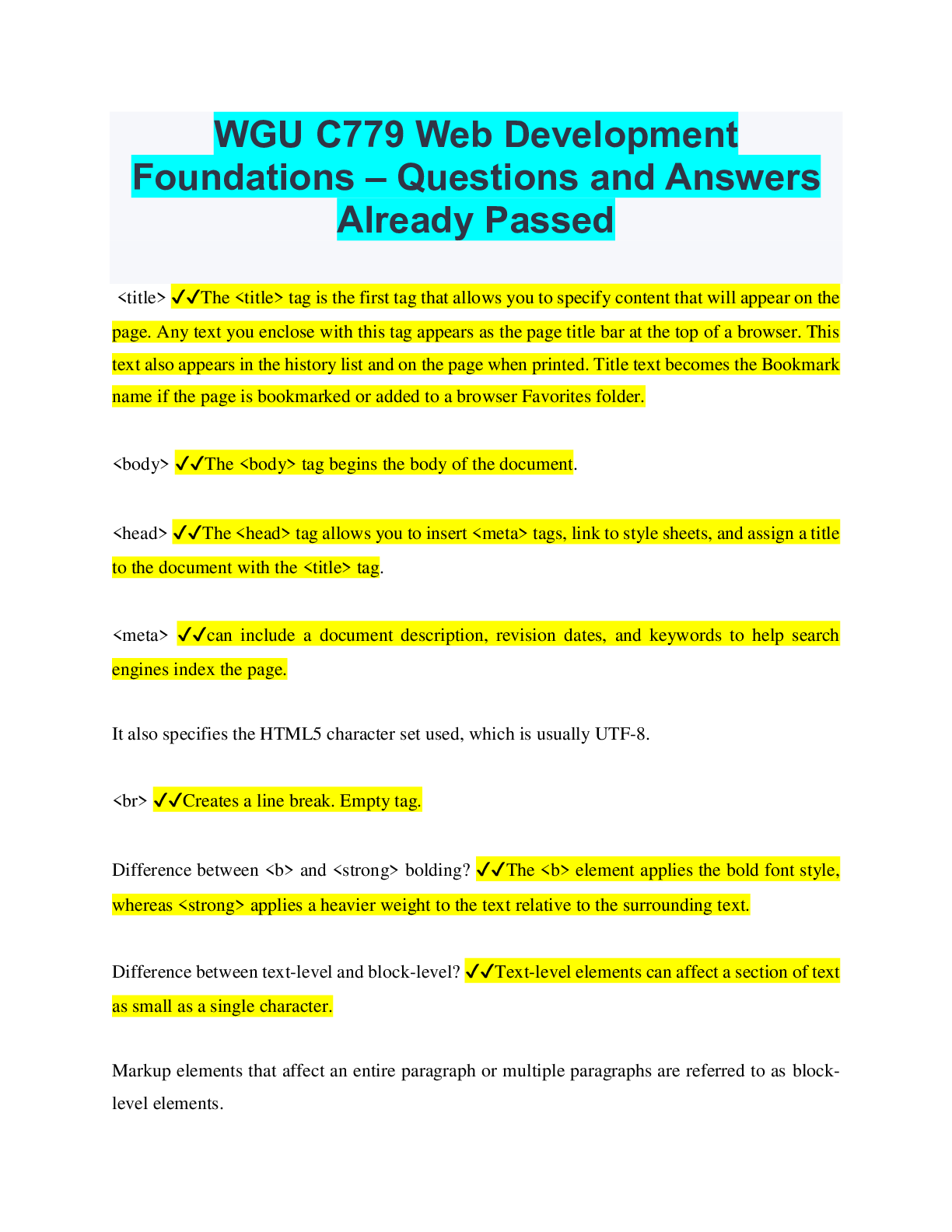
ALL PSYCHOLOGY EXAM QUESTIONS WITH ANSWERS DOCUMENTS. LATEST 2022/2023. RATED A
ALL YOU NEED TO PASS THE PSYCHOLOGY 101. ACCURATE ANSWERS, 100% PRECISE AND EASY READING DOCUMENTS. RATED A
By bundleHub Solution guider 1 year ago
$40
75
Reviews( 0 )
Recommended For You
Operations Management> QUESTIONS & ANSWERS > WGU C215 Operations Management - Objective Assessment Prep Guide & Terminologies Combo Study Guide (All)
.png)
WGU C215 Operations Management - Objective Assessment Prep Guide & Terminologies Combo Study Guide
WGU C215 Operations Management - Objective Assessment Prep Guide & Terminologies Combo Study Guide 1. customer focus 2. continuous improvement 3. employee empowerment 4. use of quality tools 5....
By Nutmegs , Uploaded: Sep 14, 2022
$11
Health Care> QUESTIONS & ANSWERS > Healthcare Operations Management - C429 2022/2023 (All)
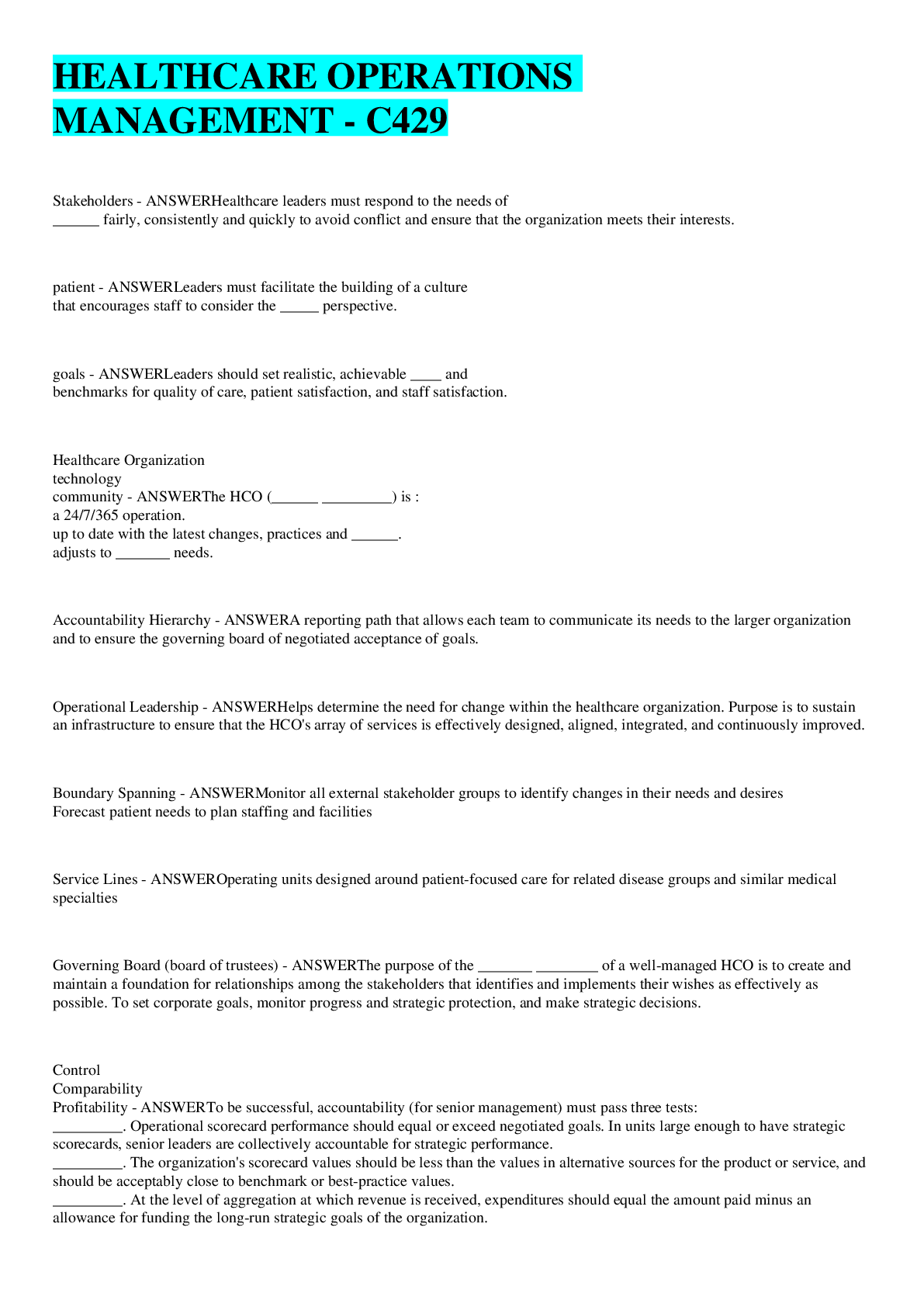
Healthcare Operations Management - C429 2022/2023
Stakeholders Healthcare leaders must respond to the needs of ______ fairly, consistently and quickly to avoid conflict and ensure that the organization meets their interests. patient Leaders m...
By Tenhang , Uploaded: Sep 24, 2022
$10
Management> QUESTIONS & ANSWERS > WGU C215 Operations Management -Objective Assessment Prep Guide & Terminologies Combo Study Guide (All)
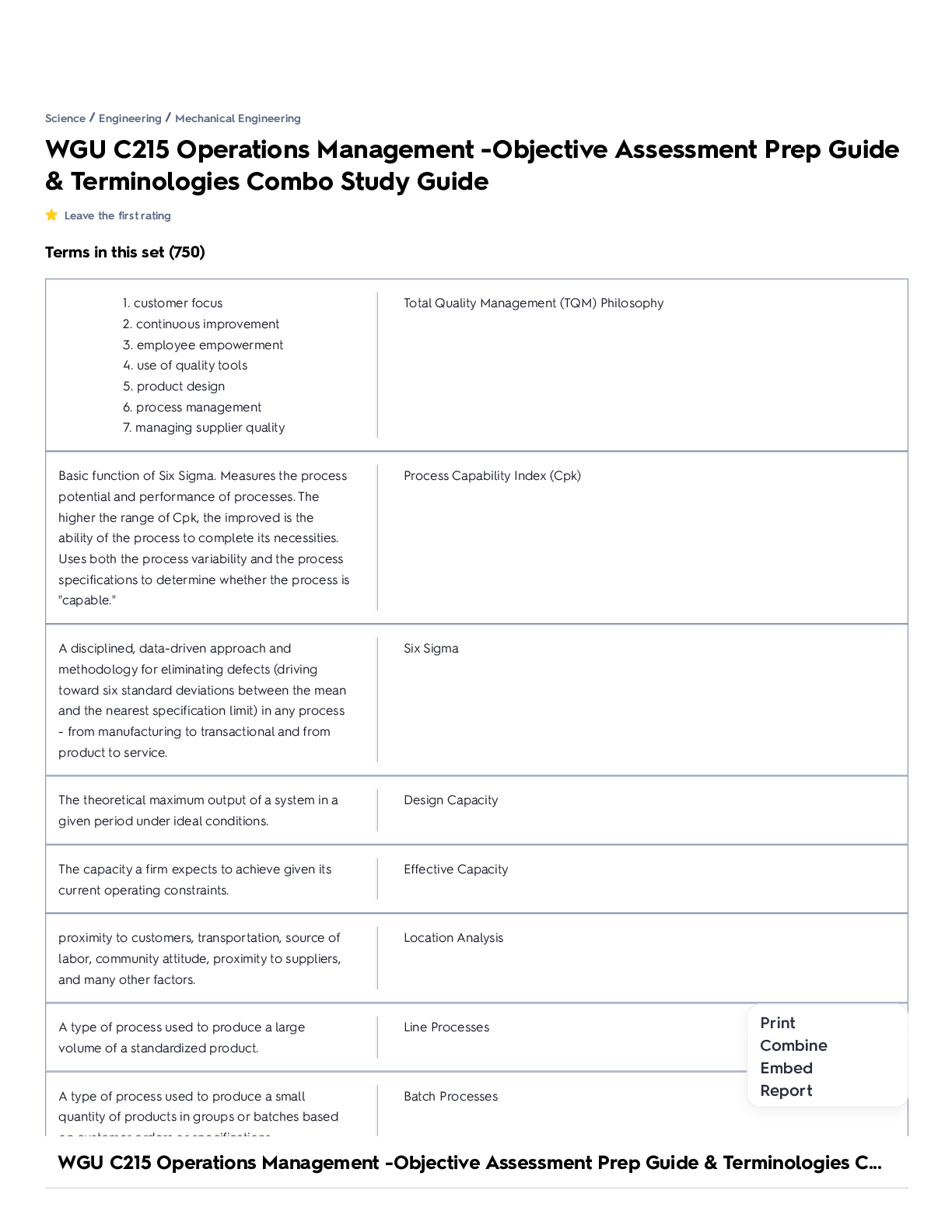
WGU C215 Operations Management -Objective Assessment Prep Guide & Terminologies Combo Study Guide
WGU C215 Operations Management -Objective Assessment Prep Guide & Terminologies Combo Study Guide 1. customer focus 2. continuous improvement 3. employee empowerment 4. use of quality tools 5. product...
By Alphascore , Uploaded: Nov 09, 2022
$9
Management> QUESTIONS & ANSWERS > WGU C215 Operations Management - Objective Assessment Prep Guide & Terminologies Combo Study Guide (All)
.png)
WGU C215 Operations Management - Objective Assessment Prep Guide & Terminologies Combo Study Guide
1. customer focus 2. continuous improvement 3. employee empowerment 4. use of quality tools 5. product design 6. process management 7. managing supplier quality ✔✔Total Quality Management (TQM)...
By clairel^ , Uploaded: Jan 27, 2023
$10
Health Care> QUESTIONS & ANSWERS > WGU C215 Operations Management -Objective Assessment Prep Guide & Terminologies Combo Study Guide 2023 (All)
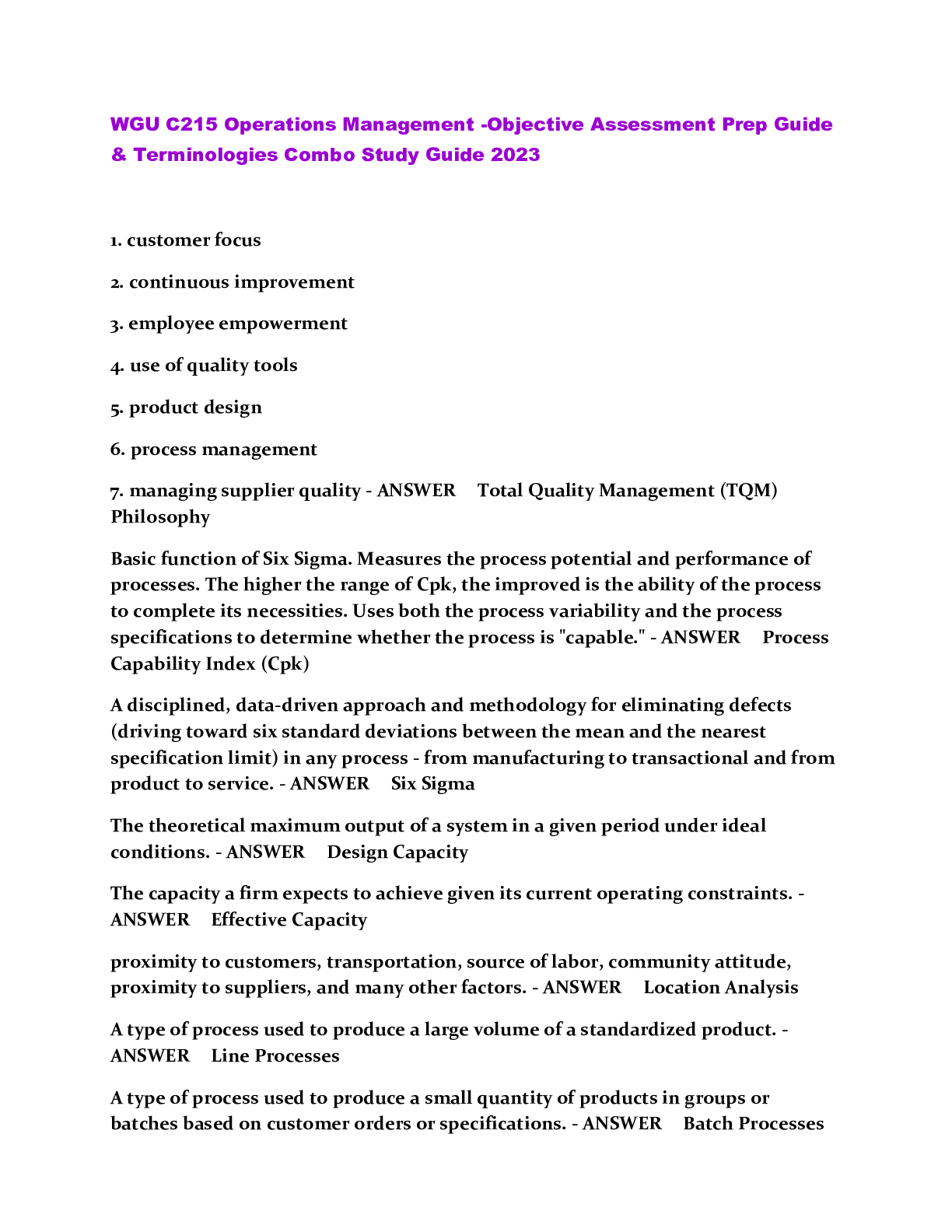
WGU C215 Operations Management -Objective Assessment Prep Guide & Terminologies Combo Study Guide 2023
WGU C215 Operations Management -Objective Assessment Prep Guide & Terminologies Combo Study Guide 2023
By Gabjay , Uploaded: Jan 31, 2023
$8
Project Management> QUESTIONS & ANSWERS > WGU C215 Operations Management - Objective Assessment Prep Guide & Terminologies Combo Study Guide. (All)

WGU C215 Operations Management - Objective Assessment Prep Guide & Terminologies Combo Study Guide.
WGU C215 Operations Management - Objective Assessment Prep Guide & Terminologies Combo Study Guide. 100% Accurate, Verified. 1. customer focus 2. continuous improvement 3. employee empowerment...
By Topmark , Uploaded: Mar 13, 2023
$10
Management> QUESTIONS & ANSWERS > WGU Operations Management - C215, Exam Section, Questions with answers, 100% Accurate, graded A+ (All)
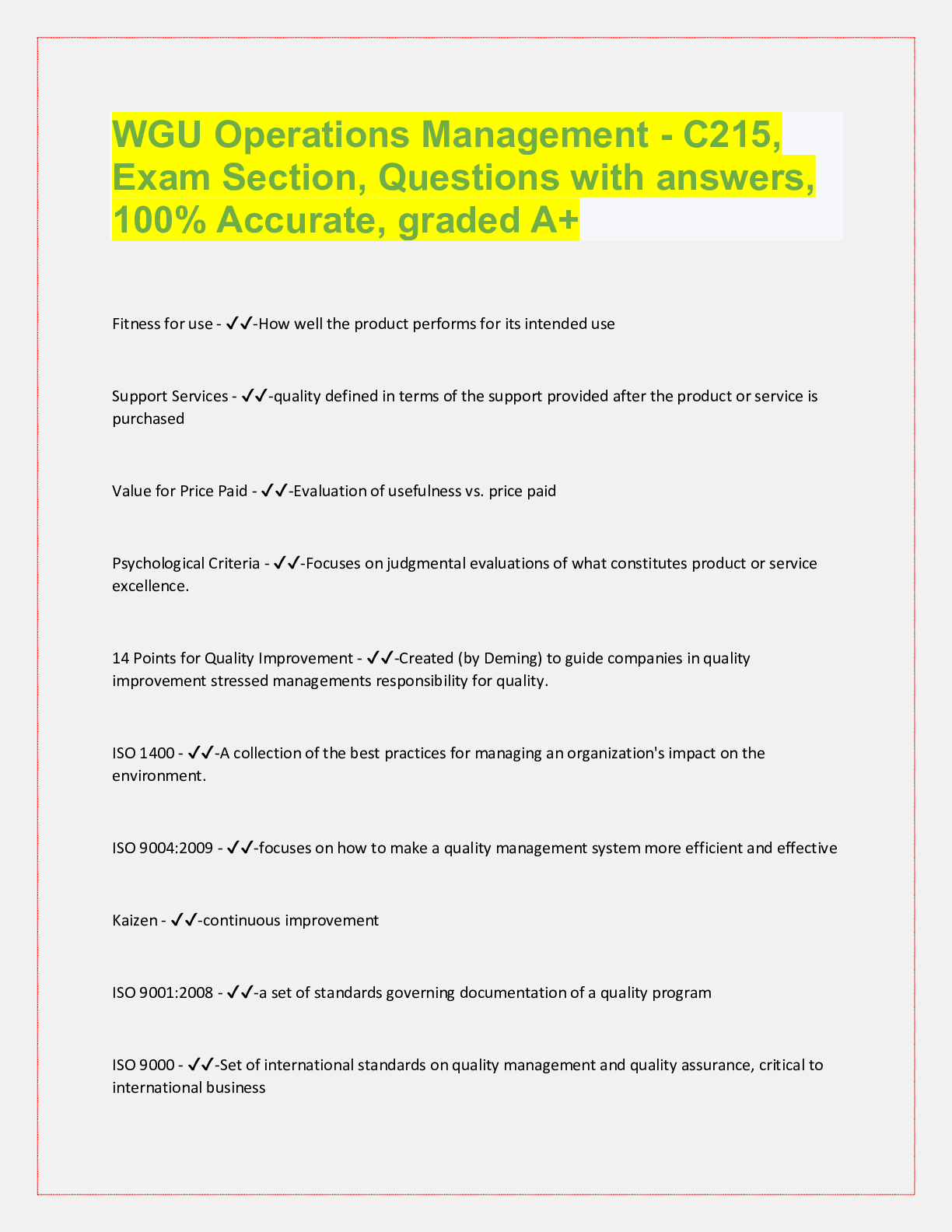
WGU Operations Management - C215, Exam Section, Questions with answers, 100% Accurate, graded A+
WGU Operations Management - C215, Exam Section, Questions with answers, 100% Accurate, graded A+ Fitness for use - ✔✔-How well the product performs for its intended use Support Services - ✔✔-qua...
By Topmark , Uploaded: Mar 14, 2023
$9
Operations Management> QUESTIONS & ANSWERS > Operations Management - How would you characterize IDEO´s process, organization, culture and management? (All)

Operations Management - How would you characterize IDEO´s process, organization, culture and management?
Operations Management - How would you characterize IDEO´s process, organization, culture and management?2 - Decision point: Should IDEO accept the Visor project as is on a dramatically reduced schedu...
By PAPERS UNLIMITED™ , Uploaded: Apr 28, 2023
$9.5
*NURSING> QUESTIONS & ANSWERS > NCSBN TEST BANK for the NCLEX-RN & NCLEX-PN. Contains More than 2000 Q&A Plus Review and Rationale in 517 PAGES. (All)

NCSBN TEST BANK for the NCLEX-RN & NCLEX-PN. Contains More than 2000 Q&A Plus Review and Rationale in 517 PAGES.
NCSBN TEST BANK -for the NCLEX-RN & NCLEX-PN. Updated 2022/2023. Contains More than 2000 Q&A Plus Review and Rationale in 517 PAGES. (All Testable Questions for NCLEX-RN & NCLEX-PN)
By Expert1 , Uploaded: Jul 28, 2020
$20
Business> QUESTIONS & ANSWERS > CLM 031 EXAM (All)
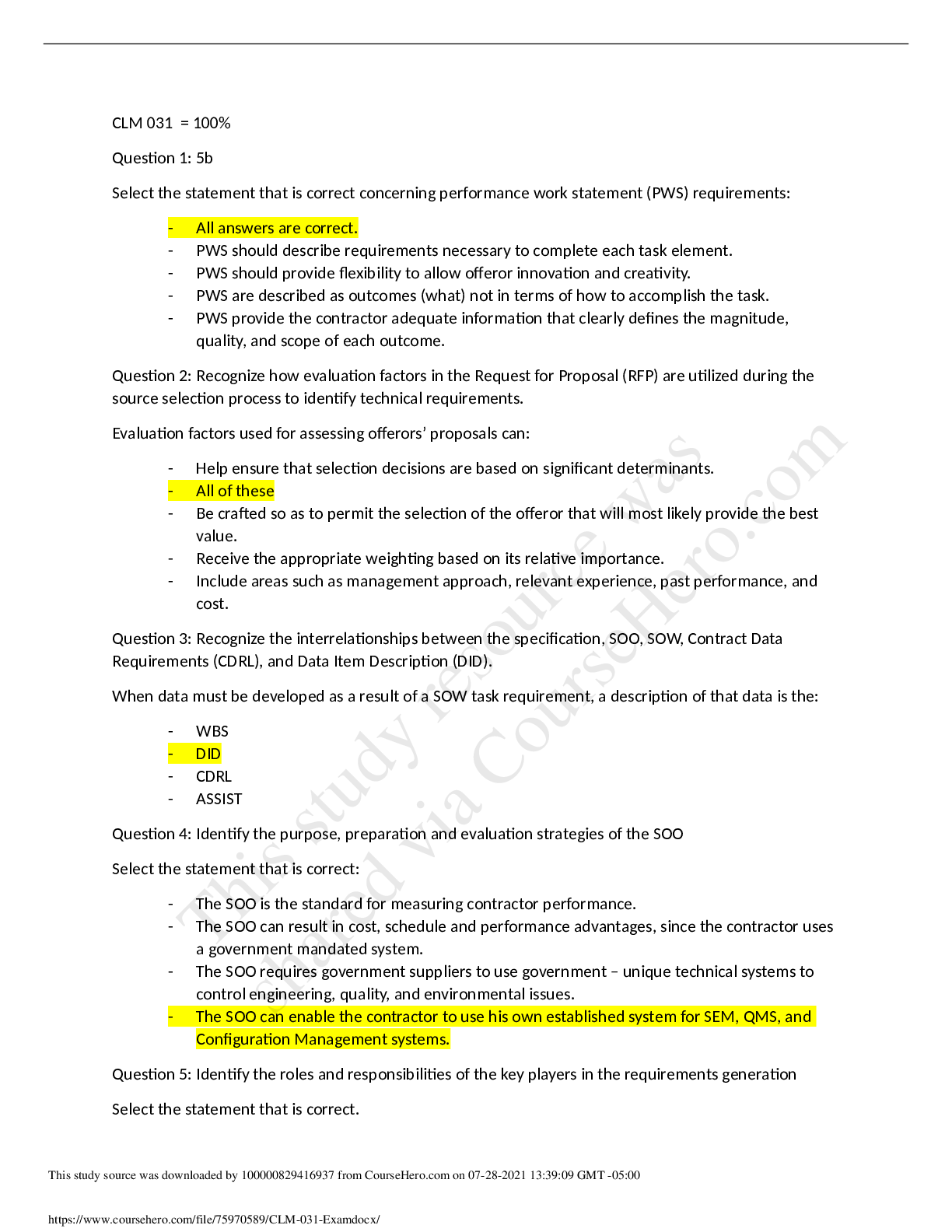
CLM 031 EXAM
CLM 031 = 100% Question 1: 5b Select the statement that is correct concerning performance work statement (PWS) requirements: - All answers are correct. - PWS should describe requirements necessary...
By Book Worm, Certified , Uploaded: Nov 03, 2022
$5
Document information
Connected school, study & course
About the document
Uploaded On
Oct 01, 2022
Number of pages
70
Written in
Additional information
This document has been written for:
Uploaded
Oct 01, 2022
Downloads
0
Views
535






